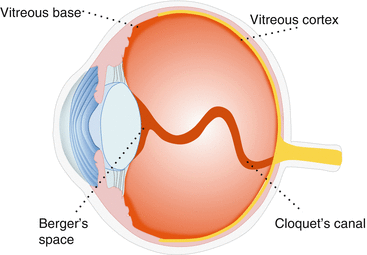(1)
University of Sydney, Sydney, Australia
Overview
Development (See Table 7.1)
Structure | Fetal age of development | Formation process | Adult derivative |
|---|---|---|---|
Primary vitreous | Weeks 4–6 | Fibrillary material secreted by the embryonic retina and hyaline artery in the optic cup | Cloquet’s canal |
Secondary vitreous | Week 6 onward | The secondary vitreous is secreted by developing retinal cells The secondary vitreous forms as the vitreous cavity enlarges and hyaloid artery regresses | Most of the adult vitreous (except Cloquet’s canal) |
Tertiary vitreous | Week 12 onward | There is condensation of fibrillary material anterior to the vitreous base | Zonular fibers |
Functions
The vitreous:
1.
Provides structural support to the retina posteriorly and lens anteriorly
The outermost portion, the cortex, consists of densely packed collagen fibrils [5].
The cortex is attached to the retinal internal limiting membrane (ILM) via anchoring fibrils.
3.
Maintains image clarity
Regulated collagen fibrillary structure within a hyaluronic acid matrix minimizes light scattering [15].
Hyaluronic acid is highly hydrated; the molecules form large open coils with widely separated anionic sites [16].
This stabilizes the structure and conformation of the collagen fibrils and minimizes light scatter [12].
4.
Acts as a gel barrier for diffusion of solutes
The vitreous gel slows but does not impede diffusion of solutes [17].
Plasma solutes slowly diffuse from retinal vessels into the posterior vitreous and then the center [18].
The gel properties prevent solutes from the anterior segment reaching high retinal concentrations; however, a small amount of solute will cross the anterior vitreous face from the aqueous fluid [19].
Oxygen is supplied by diffusion from the retinal arterioles; vitreous oxygen tension is low and reduces toward the center [21].
The vitreous can act as a reservoir extending the half life of intravitreal medications.
6.
Acts as a metabolic buffer
It is a reservoir of antioxidants and ascorbate important for lens metabolism [21].
Aging Changes
With age disintegration of the gel structure results in formation of vacuoles and opacities [24].
Cumulative light exposure, free radical-associated oxidation, and nonenzymatic glycosylation cause increased cross-linking of collagen peptide chains and hyaluronic acid degradation [25, 26].
Vitreous degeneration begins centrally where the collagen concentration is lowest [1].
Stay updated, free articles. Join our Telegram channel

Full access? Get Clinical Tree



